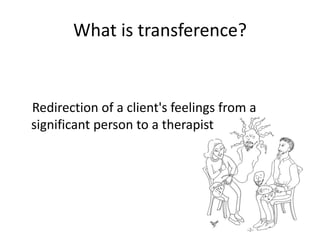Transference is the client’s emotional response to the counsellor, it’s a process of directing feelings, attitudes and conflicts to the person one has a relationship with in the present, in other words, child-like patterns of relating to significant others are repeated by the client. This operates at unconscious levels.

Clients have a tendency to create a repeated replay of situations from the past with significant others, they seem to fit all subsequent relationships to these early relationship patterns. This phenomenon is called repetition compulsion. This repetition provides an opportunity for the counsellor to study transference at close range, highlighting transference reactions, bringing these outdated or unrealistic responses into consciousness. The counsellor can help the client to recognize the “as if” quality of the transference by linking it to a past experience. (“You’re reacting to me as if I were…) He/she can help by not repeating the same reaction which the client experienced in the past. The strengths of those negative feelings can diminish by being able to express them in a safe relationship for as long as it is needed. Bringing these feelings into consciousness gives a sense of control over them. However, gaining this type of insight and changing deeply internalised attitudes can be a lengthy process. (Transference occurs in every relationship, not just in the relationship between the counsellor and the client.) Many factors can cause transference feelings such as the counsellor’s voice, accent, physical characteristics or behaviour.
Transference can be positive or negative. The client may perceive the counsellor as helpful and understanding, this way the client can relive the parent-child relationship he/she might have never had. (like a reparenting process) Other positive feelings transferred can be: loving, admiring or even idealising. On the other hand, the client can transfer negative feelings onto the counsellor, such as distrust or suspicion. It can also be a valuable opportunity for the counsellor to work with this obstructive transference by not adapting the role the client casts on him/her but by exploring the underlying issues instead.
All in all, attending to transference appropriately is crucial because it’s like a mirror in which the client’s past is reflected, it provides information about the emotional problems the client is experiencing. It can help to gain a deeper understanding of the problem.
The Triangle of Insight can also be a useful tool to explore the client’s transferential experiences. It’s a psychodynamic concept, which was developed by Karl Menninger. According to this concept, how the client perceives the relationship with the counsellor in the here (“in Here”) now is affected by the client’s earlier relationships with significant others from the past. (“Back Then”) The client’s current or recent past relationships with others are also affected. These three aspects are interrelated. The counsellor can help the client to make connections between the different aspects by working with transference and gain insight of repetitive patterns.

Counsellors can also have inappropriate strong feelings that are evoked by the clients, some of these might be evoked by the actual relationship with the client, others might belong to the counsellor’s earlier unresolved issues or own difficulties and can distort view. Although, it can be very challenging to differentiate between the two. If the counsellor can identify countertransferential feelings he should contain them and not act on them.
Supervision has a crucial role in working through these unresolved issues or blind spots and also separating the client’s needs from the counsellor’s own needs. The counsellor’s self-awareness has great importance. Countertransferential feelings or reactions include: inability to confront, being over-protective, envious and attraction towards the client. A kind of countertransference occurs when the counsellor over-identifies with the client’s problem, for example one can get angry with the perpetrator when counselling a victim of sexual abuse, this is called vicarious identification.
Clients can also project unacceptable aspects of self or feelings that can’t be expressed, this way the counsellor feels these as a recipient, this concept is called projective identification. The counsellor might experience extreme tiredness or think about the client outside sessions.
Attending to countertransference appropriately is important because this way we can provide autonomy to the client, keep the focus on the client and also put our own agenda aside.
Bibliography:
Michael Jacobs, Psychodynamic Counselling in Action SAGE Publications, Fifth edition, 2017
Margaret Hough Counselling Skills and Theory, Hodder Education, 2017
No comments:
Post a Comment